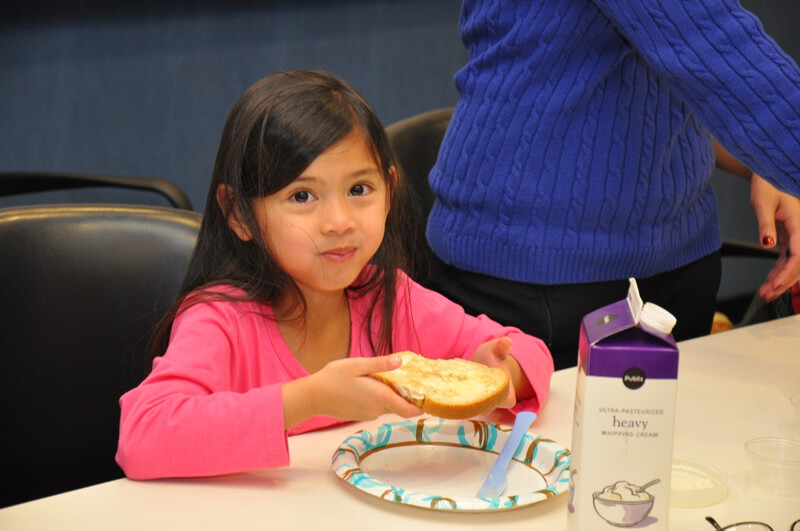
20 Aug Homemade Butter
Have you ever looked at the ingredients on a carton of butter? You might be amazed to find that salted butter is made from only cream and salt. That’s right! Nothing else! In fact, you can make your own butter if you have the right ingredients and a bit science.
Here’s What You Need
- ½ cup Heavy whipping cream
- Marble or large bead
- A small plastic container with a lid
- Plastic cup or bowl
- Bread
- Plastic spoon or knife
- Salt, Honey and/or Cinnamon (optional)
Here’s What You Do
Put the heavy whipping cream and the marble into the plastic container and put on the lid. Make sure the lid is on very tight because there is going to be a whole lot of shaking going on.
Begin to shake the container…vigorously. You should be able to hear the marble rattling around inside. Open the container from time to time and observe what is happening to the cream. It should be getting thicker. After you shake for a while, you might notice that you have something very close to whipped cream in the container. Keep shaking. Really, really shake it! After about 10 or 15 minutes of shaking, you should stop hearing the marble. Open the container. Your cream should be separated into two parts: a thin liquid (buttermilk) and a yellow solid (butter)! Pour the buttermilk into the cup or bowl. You won’t need it.
At this point, you have sweet cream butter (great on a biscuit). If you want salted butter, you can add a bit of salt. You can also add honey (honey butter), garlic salt (garlic butter), cinnamon sugar (cinnamon sugar butter), or whatever other tasty ingredient you have around the kitchen. Be creative! Now all that’s left is to grab your knife or spoon, spread your creation on some bread, and taste it. Who knew science was so delicious?!
The Science Behind the Butter
First, we need to know a bit about milk. Most people know that nearly all of the milk that we drink comes from cows. However, most people don’t know that milk is actually made up water and tiny globs of fat surrounded by a membrane. It’s kind of like tiny balloons filled with fat floating around in water. If you let fresh milk (i.e. milk right from the cow) sit around for a while, the globs of fat float to the top and form cream. The milk we get from the grocery store doesn’t do this because it has been homogenized. That means the globs of fat have been made small enough so that they are mixed evenly in the milk and will not rise to the top. Scientists call this stable suspension of solids in a liquid a colloid.
When you made your butter, you use a marble to break the membrane surrounding the globs of fat. You basically busted the fat balloon. Soon, the cream becomes filled with tiny globs of fat. These tiny globs begin to bump into each other, stick together, and form larger and larger globs of fat. After a while, you get one nice, large glob of fat. Butter!
You might notice that your butter is not as yellow as the butter that you get in the grocery store. Why is that? There are two reasons. First, some butter manufacturers add yellow coloring to their butter. The bigger reason, however, is related to the diet of the cow. Cows that eat a lot of grass produce milk that is high in a chemical called carotene. Carotene is responsible for the orange-yellow color of carrots, sweet potatoes, mangos, apricots, pumpkins, and…you guessed it…BUTTER!
Fast Fact
Have you ever wondered why people made butter in the first place? The fat that makes up butter is airtight. This means that oxygen doesn’t easily get into the butter, bacteria needs oxygen to grow. Without the bacteria, butter doesn’t spoil. As a result, butter last much longer than the milk or cream. For people living without the convenience of electric refrigerators, this made butter very, very valuable.
Check out this tasty photo gallery about Butter.
[Best_Wordpress_Gallery id=”3″ gal_title=”Butter”]

